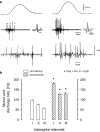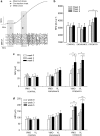Rate of force development: physiological and methodological considerations
- PMID: 26941023
- PMCID: PMC4875063
- DOI: 10.1007/s00421-016-3346-6
Rate of force development: physiological and methodological considerations
Abstract
The evaluation of rate of force development during rapid contractions has recently become quite popular for characterising explosive strength of athletes, elderly individuals and patients. The main aims of this narrative review are to describe the neuromuscular determinants of rate of force development and to discuss various methodological considerations inherent to its evaluation for research and clinical purposes. Rate of force development (1) seems to be mainly determined by the capacity to produce maximal voluntary activation in the early phase of an explosive contraction (first 50-75 ms), particularly as a result of increased motor unit discharge rate; (2) can be improved by both explosive-type and heavy-resistance strength training in different subject populations, mainly through an improvement in rapid muscle activation; (3) is quite difficult to evaluate in a valid and reliable way. Therefore, we provide evidence-based practical recommendations for rational quantification of rate of force development in both laboratory and clinical settings.
Keywords: Ballistic contraction; Dynamometry; Explosive strength; Motor unit discharge rate; Musculotendinous stiffness; Strength training.
Figures








References
-
- Aagaard P. Neural adaptations to resistance exercise. In: Cardinale M, Newton RU, Nosaka K, editors. Strength and conditioning: biological principles and practical applications. New York: Wiley-Blackwell; 2010. pp. 105–124.
-
- Aagaard P, Thorstensson A. Neuromuscular aspects of exercise: adaptive responses evoked by strength training. In: Kjaer M, editor. Textbook of sports medicine. London: Blakwell; 2003. pp. 70–106.
-
- Aagaard P, Andersen JL, Dyhre-Poulsen P, Leffers AM, Wagner A, Magnusson SP, Halkjaer-Kristensen J, Simonsen EB. A mechanism for increased contractile strength of human pennate muscle in response to strength training: changes in muscle architecture. J Physiol. 2001;534:613–623. doi: 10.1111/j.1469-7793.2001.t01-1-00613.x. - DOI - PMC - PubMed
Publication types
MeSH terms
LinkOut - more resources
Full Text Sources
Other Literature Sources
Medical

